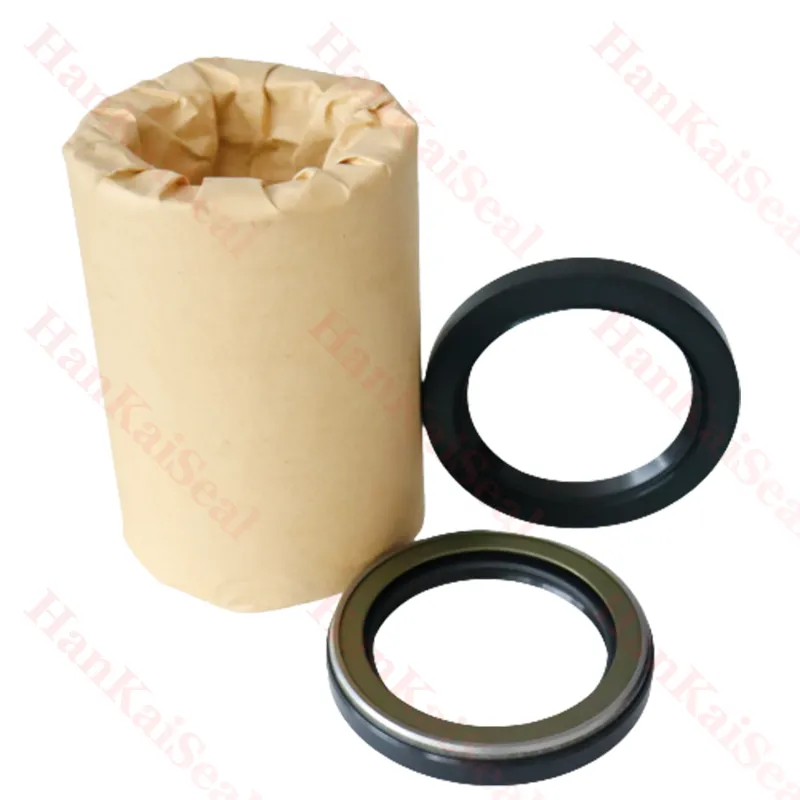maí . 21, 2025 17:30 Back to list
Hydraulic Oil Seal Material High-Temp & Pressure-Resistant Seals
- Introduction to Hydraulic Oil Seal Materials
- Key Performance Metrics for Hydraulic Cylinder Seal Kit Materials
- Material Innovations in Hydraulic Motor Oil Seals
- Technical Advantages of Leading Seal Materials
- Manufacturer Comparison: Durability and Cost Analysis
- Custom Solutions for Specific Industrial Applications
- Real-World Applications and Case Studies

(hydraulic oil seal material)
Understanding Hydraulic Oil Seal Material Essentials
Hydraulic oil seals are critical for preventing fluid leakage and maintaining system efficiency in high-pressure environments. These seals are typically manufactured from advanced polymers like Nitrile (NBR), Fluorocarbon (FKM), and Polyurethane (PU), each offering distinct advantages. For instance, NBR excels in petroleum-based hydraulic fluids, while FKM provides superior resistance to extreme temperatures (up to 250°C). Recent studies indicate that material selection impacts seal lifespan by 40-60%, emphasizing the need for precise compatibility with operating conditions.
Evaluating Hydraulic Cylinder Seal Kit Materials
Hydraulic cylinder seals demand materials that balance flexibility and rigidity. Polyurethane, known for its abrasion resistance, is widely used in dynamic applications, whereas PTFE (Polytetrafluoroethylene) is preferred for low-friction environments. Key metrics include:
- Pressure Resistance: Up to 5,000 PSI for PTFE-based seals.
- Temperature Range: -30°C to 200°C for FKM variants.
- Chemical Compatibility: Resistance to acids, oils, and hydraulic fluids.
Innovations in Hydraulic Motor Oil Seal Technology
Modern hydraulic motor seals integrate composite materials like thermoplastic elastomers (TPE) and reinforced silicone to address wear under high RPM conditions. A 2023 industry report highlighted that TPE-based seals reduce downtime by 22% in motors operating above 3,000 RPM. Additionally, dual-layer designs combining FKM and PTFE have shown a 35% improvement in leak prevention compared to single-material seals.
Technical Advantages of Advanced Seal Materials
Leading materials offer distinct technical benefits:
| Material | Temperature Range | Pressure Limit | Abrasion Resistance |
|---|---|---|---|
| NBR | -40°C to 120°C | 3,000 PSI | Moderate |
| FKM | -20°C to 250°C | 4,500 PSI | High |
| PTFE | -100°C to 260°C | 5,000 PSI | Exceptional |
Manufacturer Comparison: Durability vs. Cost
When selecting seal kits, manufacturers prioritize either longevity or budget. For example:
| Brand | Material | Avg. Lifespan | Cost per Unit (USD) |
|---|---|---|---|
| Brand A | FKM/PTFE Hybrid | 18 months | $45 |
| Brand B | NBR | 12 months | $28 |
| Brand C | Reinforced Silicone | 24 months | $62 |
Custom Solutions for Industrial Applications
Tailored hydraulic oil seal material
s address niche requirements. For offshore drilling rigs, seals with hydrogenated nitrile (HNBR) withstand seawater corrosion, while mining equipment utilizes PU seals with embedded sensors for real-time wear monitoring. Customization reduces replacement frequency by up to 50% in extreme environments.
Hydraulic Oil Seal Material Success Stories
A construction firm reported a 30% increase in hydraulic cylinder efficiency after switching to PTFE-based seals. Similarly, an agricultural machinery manufacturer reduced maintenance costs by $12,000 annually by adopting FKM seals for motor applications. These cases underscore the pivotal role of material selection in operational success.

(hydraulic oil seal material)
FAQS on hydraulic oil seal material
Q: What materials are commonly used for hydraulic oil seals?
A: Common materials include nitrile rubber (NBR), fluorocarbon (FKM), polyurethane (PU), and PTFE. These materials offer resistance to heat, pressure, and hydraulic fluids. Selection depends on operating temperature and chemical compatibility.
Q: How does hydraulic cylinder seal kit material differ from standard oil seal materials?
A: Hydraulic cylinder seal kits often combine materials like polyurethane and PTFE for dynamic seals. They prioritize wear resistance and high-pressure performance. Standard oil seals may focus more on static applications with simpler materials like NBR.
Q: What factors determine hydraulic motor oil seal material selection?
A: Key factors include rotational speed, temperature range, and fluid type. FKM is ideal for high-temperature hydraulic motors, while HNBR suits high-speed applications. Compatibility with hydraulic oil additives is also critical.
Q: Can temperature extremes affect hydraulic oil seal material performance?
A: Yes, extreme heat can degrade NBR seals, while cold may harden FKM. PTFE seals maintain flexibility across wider temperature ranges (-100°C to 260°C). Always verify material specifications for specific temperature limits.
Q: How often should hydraulic oil seal materials be replaced?
A: Replacement intervals depend on material type, operating conditions, and wear. NBR seals typically last 1-3 years, while FKM can endure 5+ years in optimal conditions. Regular inspection for leaks or cracks is recommended.
-
The Trans-formative Journey of Wheel Hub Oil Seals
NewsJun.06,2025
-
Graphene-Enhanced Oil Seals: Revolutionizing High-Pressure Oil Sealing
NewsJun.06,2025
-
Future of Hydraulic Sealing: Advanced Intelligent TCN Oil Seals
NewsJun.06,2025
-
Don’t Let a Broken TCV Oil Seal Ruin Your Day
NewsJun.06,2025
-
Bio-Inspired Dust Seals for Better Sealing Performance
NewsJun.06,2025
-
Biodegradable and Sustainable Hydraulic Seal Materials
NewsJun.06,2025
-
Top Oil Seal Solutions for Your Industrial Needs
NewsMay.22,2025
Products categories
















